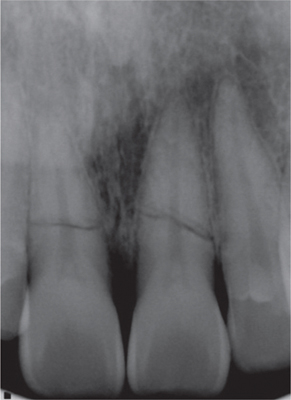Restor Dent Endod.
2012 Aug;37(3):180-184. 10.5395/rde.2012.37.3.180.
Management of horizontal root fractures by fabrication of canine protected occlusion using composite resin
- Affiliations
-
- 1Department of Conservative Dentistry, Korea University Guro Hospital, Seoul, Korea. endoshin11@gmail.com
- 2Department of Conservative Dentistry, Seoul National University Dental Hospital, Seoul, Korea.
- KMID: 1995660
- DOI: http://doi.org/10.5395/rde.2012.37.3.180
Abstract
- Traumatic injuries of the face often involve root fractures especially in anterior teeth. The prognosis and the treatment of the root fracture depend on the extent of the fracture line, general health and patient compliance. This case report outlines a new conservative trial treatment modality to stabilize the maxillary central incisors with horizontal root fracture on the cervical to middle third by fabricating canine guidance to remove loading on the traumatized maxillary central incisors during eccentric movements and thus inducing spontaneous healing of the fractured line between the fragments. Radiographs after thirty months showed adequate healing with no signs of pathological changes including root resorption, ankylosis or displacement. Long term follow-up revealed that vitality, stability and aesthetics were maintained and the patient was satisfied with the outcome.
MeSH Terms
Figure
Cited by 1 articles
-
Healing after horizontal root fractures: 3 cases with 2-year follow-up
Yoorina Choi, Sung-Ok Hong, Seok-Ryun Lee, Kyung-San Min, Su-Jung Park
Restor Dent Endod. 2014;39(2):126-131. doi: 10.5395/rde.2014.39.2.126.
Reference
-
1. Andreasen FM, Andreasen JO. Andreasen JO, Andreasen FM, editors. Root fractures. Textbook and color atlas of traumatic injuries to the teeth. 1994. 3rd ed. Copenhagen: Munksgaard;279–314.2. Calişkan MK, Pehlivan Y. Prognosis of root-fractured permanent incisors. Endod Dent Traumatol. 1996. 12:129–136.
Article3. Andreasen FM, Andreasen JO, Bayer T. Prognosis of root-fractured permanent incisors-prediction of healing modalities. Endod Dent Traumatol. 1989. 5:11–12.4. Welbury R, Kinirons MJ, Day P, Humphreys K, Gregg TA. Outcomes for root-fractured permanent incisors: a retrospective study. Pediatr Dent. 2002. 24:98–102.5. Cvek M, Mejàre I, Andreasen JO. Healing and prognosis of teeth with intra-alveolar fractures involving the cervical part of the root. Dent Traumatol. 2002. 18:57–65.
Article6. Rintaro T, Kiyotaka M, Minoru K. Conservative treatment for root fracture located very close to gingiva. Dent Traumatol. 2005. 21:111–114.
Article7. Andreasen JO, Bakland LK, Flores MT, Andreasen FM, Andersson L. Epidemiology of traumatic dental injuries. Traumatic dental injuries - a manual. 2003. 2nd ed. Oxford: Blackwell Munksgaard;10–15.8. Andreasen JO, Hjorting-Hansen E. Intraalveolar root fracture: radiographic and histologic study of 50 cases. J Oral Surg. 1967. 25:414–426.9. Andreasen JO, Andreasen FM, Mejàre I, Cvek M. Healing of 400 intra-alveolar root fractures. 1. Effect of pre-injury and injury factors such as sex, age, stage of root development, fracture type, location of fracture and severity of dislocation. Dent Traumatol. 2004. 20:192–202.
Article10. Wakefield CW, Kofford KR. Advances in restorative materials. Dent Clin North Am. 2001. 45:7–29.
- Full Text Links
- Actions
-
Cited
- CITED
-
- Close
- Share
- Similar articles
-
- Fracture resistance of crown-root fractured teeth repaired with dual-cured composite resin and horizontal posts
- Occlusal scheme in a group of Thais
- Effect of different lateral occlusion schemes on peri-implant strain: A laboratory study
- Color Matching of Single-Shade Composite Resin by Various Pulp Capping Materials in Anterior Teeth
- Effect of delayed time, surface treatment, and repair material on shear bond strength of repaired bis-acryl composite resin







